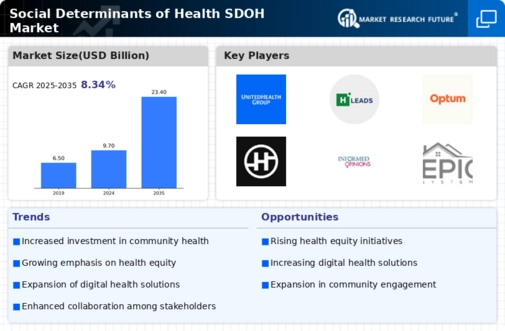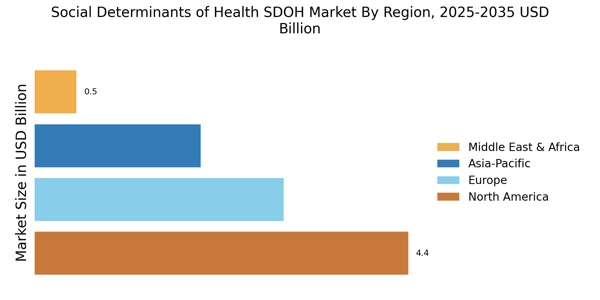Policy and Regulatory Support
Government policies and regulations play a crucial role in shaping the Social Determinants of Health SDOH Market. Recent legislative efforts aimed at improving health outcomes have led to increased funding for programs that address social determinants. For instance, initiatives that allocate resources for affordable housing and education have gained traction, reflecting a commitment to enhancing public health. The Centers for Disease Control and Prevention has reported that investments in social determinants can yield a return of up to 4 dollars for every dollar spent. This financial incentive encourages stakeholders to prioritize health equity, thereby driving growth in the Social Determinants of Health SDOH Market.
Focus on Preventive Health Strategies
The emphasis on preventive health strategies is reshaping the Social Determinants of Health SDOH Market. By prioritizing prevention over treatment, stakeholders aim to address the root causes of health issues linked to social determinants. Programs that promote healthy lifestyles, education, and access to resources are gaining momentum. The World Health Organization has indicated that investing in preventive measures can reduce healthcare costs by up to 30%. This focus on prevention not only improves individual health outcomes but also alleviates the burden on healthcare systems. Consequently, the Social Determinants of Health SDOH Market is evolving to support initiatives that foster long-term health improvements.
Rising Awareness of Health Disparities
The increasing recognition of health disparities among various populations is a pivotal driver in the Social Determinants of Health SDOH Market. As stakeholders, including governments and non-profit organizations, emphasize the need for equitable health outcomes, there is a growing demand for solutions that address these disparities. Reports indicate that nearly 25% of individuals in underserved communities experience barriers to accessing healthcare. This awareness propels investments in programs aimed at improving social determinants such as education, income, and housing. Consequently, the Social Determinants of Health SDOH Market is witnessing a surge in initiatives designed to promote health equity, thereby enhancing overall community well-being.
Increased Investment from Private Sector
The private sector's growing interest in addressing social determinants is a significant driver in the Social Determinants of Health SDOH Market. Corporations are increasingly recognizing the impact of social factors on health outcomes and are investing in community health initiatives. For instance, companies are funding programs that provide access to nutritious food and safe housing, which are essential components of social determinants. This investment is not only beneficial for communities but also enhances corporate social responsibility profiles. As a result, the Social Determinants of Health SDOH Market is experiencing a shift towards collaborative efforts between private entities and public health organizations.
Technological Advancements in Data Analytics
The integration of advanced data analytics technologies is transforming the Social Determinants of Health SDOH Market. With the advent of big data and machine learning, organizations can now analyze vast amounts of information related to social determinants, leading to more informed decision-making. For example, predictive analytics can identify at-risk populations, enabling targeted interventions. The market for health analytics is projected to reach 50 billion dollars by 2026, underscoring the potential of technology to enhance understanding and address social determinants. This trend not only improves health outcomes but also fosters innovation within the Social Determinants of Health SDOH Market.


















Leave a Comment